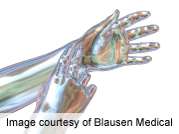(HealthDay) -- For patients with rheumatoid arthritis (RA), female gender and having a high proportion of disease activity score (DAS28) attributable to patient-reported components (joint tenderness and visual analog score) (DAS28-P) at baseline are predictive of less improvement in pain at one year, according to a study published online May 3 in Arthritis Care & Research.
Daniel F. McWilliams, Ph.D., of the University of Nottingham in the United Kingdom, and colleagues assessed the change in pain at one year using data from the Early Rheumatoid Arthritis Network database cohort of 1,189 individuals who completed the Short-Form-36 questionnaire bodily pain scores. Predictors of improvement in pain were investigated and the DAS28-P was measured at baseline.
At baseline, the researchers found that greater pain was associated with gender, poor mental health, smoking status, and high DAS28. The majority of patients continued to report bodily pain after one year. For patients whose disease remained active, the DAS28-P index did not change significantly. Significant predictors of less improvement in pain were female gender (adjusted odds ratio [aOR], 3.41) and high DAS28-P at baseline (aOR for tertiles, 2.09). Pain changes were not predicted by other conventional RA risk factors.
"The factors most likely to be related to poorer pain outcomes in early RA are female gender and a high baseline DAS28-P index," the authors write. "A high DAS28-P index may reflect greater contributions of non-inflammatory factors, such as central sensitization, to pain. Strategies in addition to inflammatory disease suppression may be required to adequately treat pain."
Two of the authors disclosed financial ties to Pfizer, which funded the data analysis for this study.
More information:
Abstract
Full Text (subscription or payment may be required)
Journal information: Arthritis Care & Research
Copyright © 2012 HealthDay. All rights reserved.


















